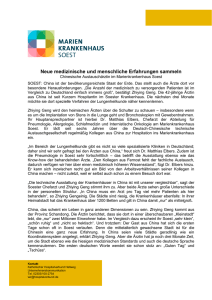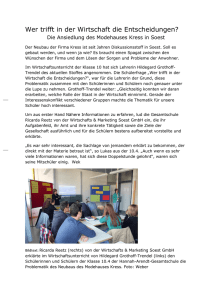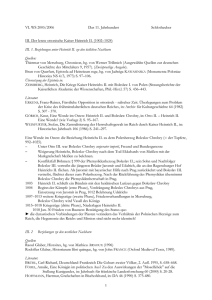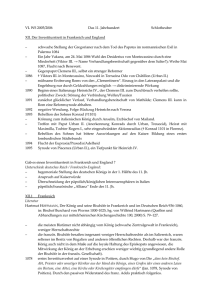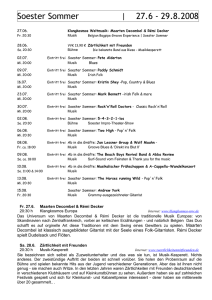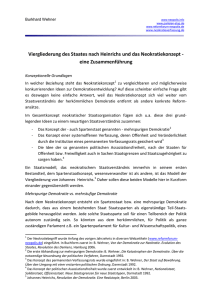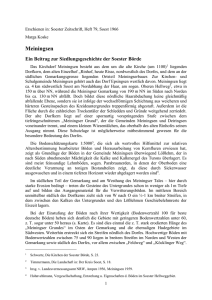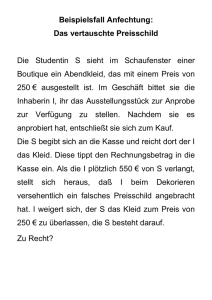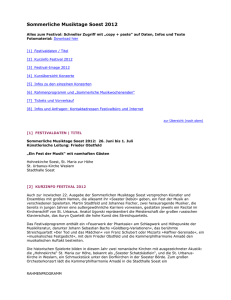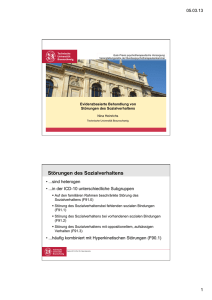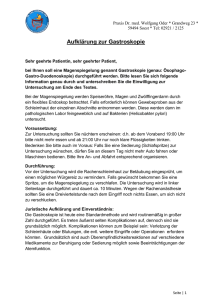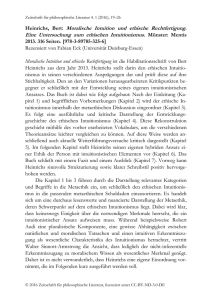Oxytocin
Werbung
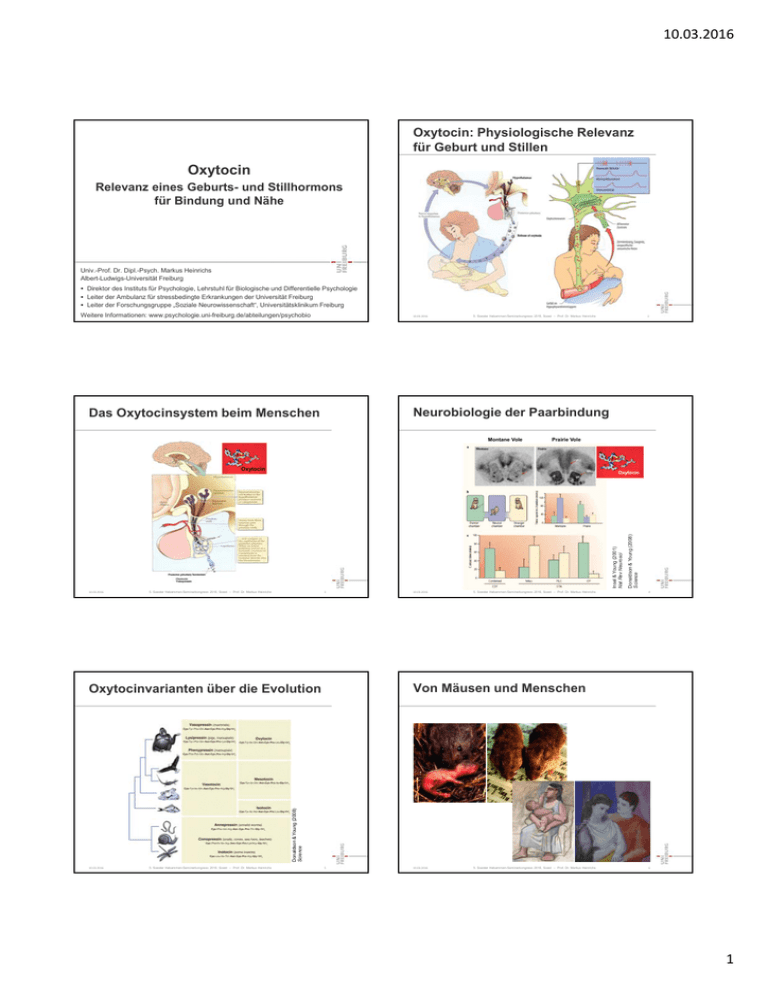
10.03.2016 Oxytocin: Physiologische Relevanz für Geburt und Stillen Oxytocin Relevanz eines Geburts- und Stillhormons für Bindung und Nähe Univ.-Prof. Dr. Dipl.-Psych. Markus Heinrichs Albert-Ludwigs-Universität Freiburg Direktor des Instituts für Psychologie, Lehrstuhl für Biologische und Differentielle Psychologie Leiter der Ambulanz für stressbedingte Erkrankungen der Universität Freiburg Leiter der Forschungsgruppe „Soziale Neurowissenschaft“, Universitätsklinikum Freiburg Weitere Informationen: www.psychologie.uni-freiburg.de/abteilungen/psychobio 10.03.2016 5. Soester Hebammen-Seminarkongress 2016, Soest – Prof. Dr. Markus Heinrichs 22 Neurobiologie der Paarbindung Das Oxytocinsystem beim Menschen Montane Vole Prairie Vole Oxytocin 10.03.2016 5. Soester Hebammen-Seminarkongress 2016, Soest – Prof. Dr. Markus Heinrichs 3 10.03.2016 5. Soester Hebammen-Seminarkongress 2016, Soest – Prof. Dr. Markus Heinrichs Donaldson & Young (2008) Science Insel & Young (2001) Nat Rev Neurosci Oxytocin 4 Von Mäusen und Menschen Donaldson & Young (2008) Science Oxytocinvarianten über die Evolution 10.03.2016 5. Soester Hebammen-Seminarkongress 2016, Soest – Prof. Dr. Markus Heinrichs 5 10.03.2016 5. Soester Hebammen-Seminarkongress 2016, Soest – Prof. Dr. Markus Heinrichs 6 1 10.03.2016 Schutzfaktor soziale Interaktion Oxytocin im Gehirn des Menschen Positive soziale Interaktion (v. a. soziale Unterstützung) hat vielfältige protektive Effekte bei somatischen, psychischen, und psychosomatischen Erkrankungen (Baumgartner, Heinrichs et al., 2008, Neuron; Cohen et al., 1997, JAMA; Colonnello & Heinrichs, 2014, Psychoneuroendocrinology; Ditzen & Heinrichs, 2013, Restor Neurol Neurosci; Heinrichs et al., 2003, Biol Psychiatry; Heinrichs et al., 2005, Am J Psychiatry; Heinrichs & Domes, 2008, Prog Brain Res; Heinrichs & Gaab, 2007, Curr Opin Psychiatry; House et al., 1988, Science; Soravia, Heinrichs et al., 2006, Proc Natl Acad Sci; von Dawans et al., 2012, Psychol Sci) Welche Mechanismen liegen der protektiven Wirkung positiver sozialer Interaktion (soziale Unterstützung, Bindung, Vertrauen) zugrunde? Meyer-Lindenberg, Domes, Kirsch & Heinrichs (2011) Nature Reviews Neuroscience 10.03.2016 5. Soester Hebammen-Seminarkongress 2016, Soest – Prof. Dr. Markus Heinrichs 7 5. Soester Hebammen-Seminarkongress 2016, Soest – Prof. Dr. Markus Heinrichs 10.03.2016 8 Intranasale Applikation von Neurohormonen Von der Nase ins Gehirn (CSF) Born et al. (2002) Nat Neurosci Heinrichs et al. (2004) Physiol Behav Quintana et al. (2015) Neuroscience and Biobehavioral Reviews 10.03.2016 5. Soester Hebammen-Seminarkongress 2016, Soest – Prof. Dr. Markus Heinrichs 9 Psychosozialer Stress im Labor 10.03.2016 5. Soester Hebammen-Seminarkongress 2016, Soest – Prof. Dr. Markus Heinrichs 10 Neurohormonelle Stressreaktion Trier Social Stress Test (TSST) CRH ACTH Cortisol Kirschbaum, Pirke & Hellhammer (1993) Neuropsychobiology von Dawans, Kirschbaum & Heinrichs (2011) Psychoneuroendocrinology von Dawans, Fischbacher, Kirschbaum, Fehr & Heinrichs (2012) Psychological Science 10.03.2016 5. Soester Hebammen-Seminarkongress 2016, Soest – Prof. Dr. Markus Heinrichs 11 10.03.2016 5. Soester Hebammen-Seminarkongress 2016, Soest – Prof. Dr. Markus Heinrichs 12 2 10.03.2016 Psychobiologische Stressdiagnostik Stimulation des Oxytocin-Systems Stillen Intranasale Applikation Körperkontakt von Dawans, Kirschbaum & Heinrichs (2011) Psychoneuroendocrinology 10.03.2016 5. Soester Hebammen-Seminarkongress 2016, Soest – Prof. Dr. Markus Heinrichs 13 5. Soester Hebammen-Seminarkongress 2016, Soest – Prof. Dr. Markus Heinrichs 10.03.2016 Stillen als Stressschutz bei Müttern? Stresshormon-Reaktion und Stillen -45 -30 -20 -10 Preparation Introduction STRESS BreastFeeding vs. IV Mood Catheter Anxiety Holding 0 10 20 30 40 55 5. Soester Hebammen-Seminarkongress 2016, Soest – Prof. Dr. Markus Heinrichs Körperkontakt 70 = Plasma Samples = Saliva Samples 15 ◦ Breast-Feeding Holding STRESS ◦ Breast-Feeding Holding Heinrichs et al. (2002) Stress 10.03.2016 Heinrichs et al. (2001) J Clin Endocrinol Metab 5. Soester Hebammen-Seminarkongress 2016, Soest – Prof. Dr. Markus Heinrichs 16 Stresshormon-Reaktion und soziale Unterstützung Stimulation des Oxytocin-Systems Stillen Trier Social Stress Mood Test Anxiety Time (min) 10.03.2016 14 Intranasale Applikation Kirschbaum et al. (1995) Psychosom Med 10.03.2016 5. Soester Hebammen-Seminarkongress 2016, Soest – Prof. Dr. Markus Heinrichs 17 10.03.2016 5. Soester Hebammen-Seminarkongress 2016, Soest – Prof. Dr. Markus Heinrichs 18 3 10.03.2016 Stresshormon-Reaktion und Berührung -45 -30 -20 -10 10 20 60 30 40 50 AUCi Trier Social Stress Mood Test Anxiety 0 A 30 20 25 10 Mean Salivary Cortisol, nmol/L Mood Anxiety Alone vs. Social Support vs. Physical Contact Preparation (alone) IV Catheter Introduction Berührung als Stressschutz? 30 40 50 No Interaction Social Support Physical Contact 15 10 No Interaction 60 5 Social Support = Plasma Samples = Saliva Samples Time (min) 0 20 Physical Contact 0 -20 -10 0 10 20 30 40 50 Time, min Ditzen, Neumann, Bodenmann, von Dawans, Turner, Ehlert & Heinrichs (2007) Psychoneuroendocrinology 5. Soester Hebammen-Seminarkongress 2016, Soest – Prof. Dr. Markus Heinrichs 10.03.2016 19 10.03.2016 Kardiovaskuläre Stress-Reaktion und Berührung B 20 Stimulation des Oxytocin-Systems 370 270 Intranasale Applikation Körperkontakt Stillen 320 AUCi 5. Soester Hebammen-Seminarkongress 2016, Soest – Prof. Dr. Markus Heinrichs 220 170 120 70 0 No Interaction Mean Heart Rate, Beats/min 110 Social Support Physical Contact 90 No Interaction Social Support Physical Contact 70 0 -5 -4 -3 -2 -1 0 1 2 3 4 5 6 7 8 9 10 11 12 13 14 Time, min Ditzen, Neumann, Bodenmann, von Dawans, Turner, Ehlert & Heinrichs (2007) Psychoneuroendocrinology 10.03.2016 5. Soester Hebammen-Seminarkongress 2016, Soest – Prof. Dr. Markus Heinrichs 21 10.03.2016 Oxytocin vs. Placebo (intranasally double-blind) -50 Mood Anxiety -30 -20 Introduction Oxytocin und soziale Unterstützung bei Stress 22 Oxytocin und soziale Unterstützung bei Stress Social Trier Support Social vs. Stress Mood Alone Test Anxiety -10 0 10 Time (min) 10.03.2016 5. Soester Hebammen-Seminarkongress 2016, Soest – Prof. Dr. Markus Heinrichs 5. Soester Hebammen-Seminarkongress 2016, Soest – Prof. Dr. Markus Heinrichs 20 30 40 55 70 STRESS Heinrichs, Baumgartner, Kirschbaum & Ehlert (2003) Biological Psychiatry = Saliva Samples 23 10.03.2016 5. Soester Hebammen-Seminarkongress 2016, Soest – Prof. Dr. Markus Heinrichs 24 4 10.03.2016 Varianten des Oxytocin-Rezeptor-Gens, soziale Unterstützung und Stress Genetische Varianten des Oxytocin-Rezeptor-Gens Untranslated region Coding region Heinrichs & Domes (2008) Progress in Brain Research Intron A/G Minor allele frequency ~30% Meyer-Lindenberg, Domes, Kirsch & Heinrichs (2011) Nature Reviews Neuroscience Heinrichs, von Dawans & Domes (2009) Frontiers in Neuroendocrinology Kumsta & Heinrichs (2013) Current Opinion in Neurobiology 5. Soester Hebammen-Seminarkongress 2016, Soest – Prof. Dr. Markus Heinrichs 10.03.2016 Chen, Kumsta, von Dawans, Monakhov, Ebstein & Heinrichs (2011) Proc Natl Acad Sci 25 Oxytocin und Vertrauen 5. Soester Hebammen-Seminarkongress 2016, Soest – Prof. Dr. Markus Heinrichs 10.03.2016 26 Das „Vertrauensspiel“ 3 5. Soester Hebammen-Seminarkongress 2016, Soest – Prof. Dr. Markus Heinrichs 27 12 11 10 9 8 7 6 5 4 3 2 1 0 5. Soester Hebammen-Seminarkongress 2016, Soest – Prof. Dr. Markus Heinrichs 28.06.2012 Placebo group 9.6 8.1 Placebo 28 Oxytocin und Vertrauen R e la tive fre q u e nc y Average transfer of player 1 Oxytocin und Vertrauen Spieler B Oxytocin Kosfeld*, Heinrichs* et al. (2005) Nature Oxytocin group 0.50 0.45 0.40 0.35 0.30 0.25 0.20 0.15 0.10 0.05 0.00 Kosfeld*, Heinrichs* et al. (2005) Nature 10.03.2016 Spieler A 0 1 2 3 4 5 6 7 8 9 10 11 12 Individual investor's average transfer (MUs) Trust experiment 10.03.2016 5. Soester Hebammen-Seminarkongress 2016, Soest – Prof. Dr. Markus Heinrichs 29 10.03.2016 5. Soester Hebammen-Seminarkongress 2016, Soest – Prof. Dr. Markus Heinrichs 30 5 10.03.2016 Soziale Beziehungsfähigkeit versus „soziale Störung“ „We are, by nature, a highly affiliative species craving social contact. When social experience becomes a source of anxiety rather than a source of comfort, we have lost something fundamental – whatever we call it.“ „Psychobiologische Therapie“ ?! THOMAS R. INSEL Director NIMH, USA 10.03.2016 5. Soester Hebammen-Seminarkongress 2016, Soest – Prof. Dr. Markus Heinrichs 31 10.03.2016 5. Soester Hebammen-Seminarkongress 2016, Soest – Prof. Dr. Markus Heinrichs 32 Beispiel soziale Phobie: Oxytocin normalisiert die neuronale Reaktivität „Soziale Störungen“: Psychische Störungen mit sozialen Defiziten Soziale Phobie Dritthäufigste psychische Störung nach Depression und Alkoholismus Prävalenz (lifetime) für soziale Phobie in Europa: 7-12% Therapieeffektivität im Vergleich zu anderen Angststörungen am niedrigsten (< 55%) Autismus (ASD) Prävalenz: ca. 60/10.000 Kindern Kausale Therapie autistischer Störungen bislang nicht möglich Borderline-Persönlichkeitsstörung Prävalenz: 1-6% > 50% der Patienten nicht erfolgreich therapierbar Labuschagne et al. (2010) Neuropsychopharmacology 10.03.2016 5. Soester Hebammen-Seminarkongress 2016, Soest – Prof. Dr. Markus Heinrichs 33 Beispiel Autismus: Oxytocin und Gesichtsverarbeitung 10.03.2016 5. Soester Hebammen-Seminarkongress 2016, Soest – Prof. Dr. Markus Heinrichs 34 Beispiel Autismus: Oxytocin und Gesichtsverarbeitung Domes, Heinrichs et al. (2013) Biol Psychiatry Domes, Heinrichs et al. (2013) Biol Psychiatry 10.03.2016 5. Soester Hebammen-Seminarkongress 2016, Soest – Prof. Dr. Markus Heinrichs 35 10.03.2016 5. Soester Hebammen-Seminarkongress 2016, Soest – Prof. Dr. Markus Heinrichs 36 6 10.03.2016 Beispiel Autismus: Oxytocin und „Gefühle lesen“ Reading the Mind in the Eyes Test (RMET) Baron-Cohen et al. (2001) Journal of Child Psychology and Psychiatry 10.03.2016 5. Soester Hebammen-Seminarkongress 2016, Soest – Prof. Dr. Markus Heinrichs 37 10.03.2016 Biologische Psychologie (Vorlesung 5) – Prof. Dr. Markus Heinrichs 38 Oxytocin und „Gefühle lesen“ bei Jugendlichen mit Autismus Oxytocin und „Gefühle lesen“ Guastella et al. (2009) Biological Psychiatry Domes, Heinrichs et al. (2007) Biological Psychiatry 10.03.2016 5. Soester Hebammen-Seminarkongress 2016, Soest – Prof. Dr. Markus Heinrichs 39 10.03.2016 5. Soester Hebammen-Seminarkongress 2016, Soest – Prof. Dr. Markus Heinrichs 40 Ich schau Dir in die Augen… Blickkontakt Guastella et al. (2008) Biol Psychiatry 10.03.2016 5. Soester Hebammen-Seminarkongress 2016, Soest – Prof. Dr. Markus Heinrichs 41 10.03.2016 5. Soester Hebammen-Seminarkongress 2016, Soest – Prof. Dr. Markus Heinrichs 42 7 10.03.2016 Neurobiologie und Psychotherapie: Translationaler Ansatz PROSOCIAL BEHAVIOR + SOCIAL ANXIETY/STRESS Coping ? Social Support – Approach Behavior – Physical Contact Amygdala-Cingulate Circuits Hypothalamic-PituitaryAdrenal Axis + + CENTRAL OXYTOCINERGIC SYSTEM + ? Social Buffering - Secretion – Receptors – Genetics HEALTH Heinrichs, Chen & Domes (2012). Oxytocin. In Hofmann (Ed.), Psychobiological Approaches for Anxiety Disorders: Treatment Combination Strategies. Oxford: Wiley-Blackwell. Heinrichs, Chen, Domes & Kumsta (2013). Social stress and social approach. In Armony & Vuilleumier (Eds.), The Cambridge Handbook of Human Affective Neuroscience. Cambridge University Press. Heinrichs, Chen & Domes (2013). Social neuropeptides in the human brain: oxytocin and social behavior. In Baron-Cohen, Tager-Flusberg & Lombardo (Eds.), Understanding Other Minds. Oxford UniversityPress. 10.03.2016 BEHAVIOR THERAPY 5. Soester Hebammen-Seminarkongress 2016, Soest – Prof. Dr. Markus Heinrichs + PSYCHOBIOLOGICAL THERAPY + ? OXYTOCIN TREATMENT PSYCHOPATHOLOGY (e.g., Autism, Social Phobia, Borderline Personality Disorder) 43 Dank an das ganze Team Wissenschaftliches Personal Eva Bareth, M.Sc. Valentina Colonnello, Ph.D. PD Dr. Gregor Domes Katharina Glatz, M.Sc. Petra Kamelger, M.Sc. Dipl.-Psych. Manuela Kanat Dr. Nicole Ower Dr. Bastian Schiller Dipl.-Psych. Laura Seebauer Dr. Tobias Stächele Marion Schwaiger, M.Sc. Livia Tomova, M.Sc. Amalie Trüg, M.Sc. Dr. Bernadette von Dawans Administratives und technisches Personal Julia Albicker, B.Sc. Marie Habermann Birgit Bühren, Admin Lisa Marx Rob Falkenstein, IT Ines Spenthof, B.Sc. Olivia Fellinger, Admin Antonia Vehlen Marlon Grodd, IT 10.03.2016 5. Soester Hebammen-Seminarkongress 2016, Soest – Prof. Dr. Markus Heinrichs 44 Forschungsförderung Ehemalige Mitarbeiterinnen und Mitarbeiter Prof. Dr. Frances S. Chen (University of British Columbia, Vancouver) Prof. Dr. Beate Ditzen (Universität Heidelberg) Dr. Janine Germann (Universität Zürich, Schweiz) Prof. Dr. Robert Kumsta (Universität Bochum) Prof. Dr. Janek Lobmaier (Universität Bern, Schweiz) Prof. Dr. Gunther Meinlschmidt (Basel, Schweiz) Dr. Ulrike Rimmele (New York University) Dr. Leila M. Soravia (Universität Bern, Schweiz) Tri-National Neuroscience Upper-Rhine Network 10.03.2016 5. Soester Hebammen-Seminarkongress 2016, Soest – Prof. Dr. Markus Heinrichs 45 10.03.2016 5. Soester Hebammen-Seminarkongress 2016, Soest – Prof. Dr. Markus Heinrichs 46 8
